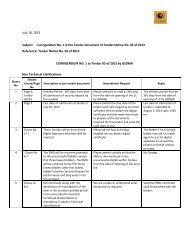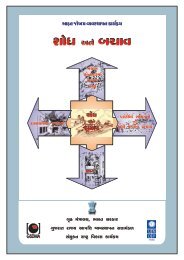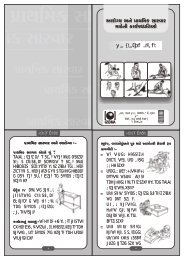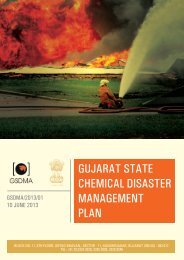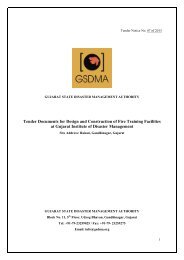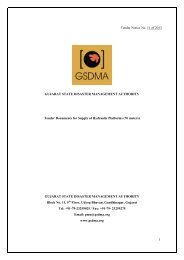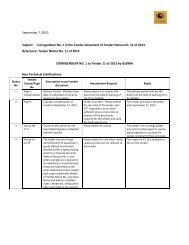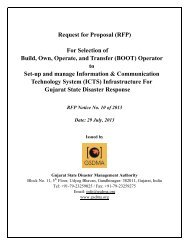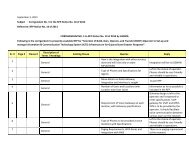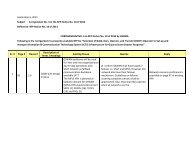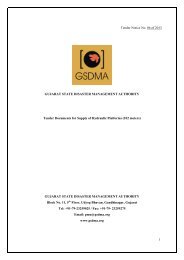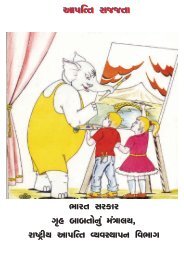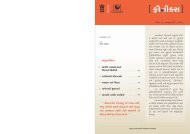Emergency Response Guidebook - Gujarat State Disaster ...
Emergency Response Guidebook - Gujarat State Disaster ...
Emergency Response Guidebook - Gujarat State Disaster ...
Create successful ePaper yourself
Turn your PDF publications into a flip-book with our unique Google optimized e-Paper software.
Flash pointGlossaryLowest temperature at which a liquid or solid gives off Vapour in sucha concentration that, when the Vapour combines with air near thesurface of the liquid or solid, a flammable mixture is formed. Hence,the lower the flash point, the more flammable the material.Hazard zones HAZARD ZONE A: Gases: LC50 of less than or equal to(Inhalation Hazard200 ppm,Zones)Liquids: V equal to or greater than 500 LC50and LC50 less than or equal to 200 ppm,Hot zoneIEDImmiscibleImprovised ExplosiveDeviceLarge spillLc50HAZARD ZONE B:HAZARD ZONE C:HAZARD ZONE D:Gases: LC50 greater than 200 ppm and lessthan or equal to 1000 ppm, Liquids: V equal toor greater than 10 LC50; LC50 less than orequal to 1000 ppm and criteria for HazardZone A are not met.LC50 greater than 1000 ppm and less than orequal to 3000 ppm,LC50 greater than 3000 ppm and less than orequal to 5000 ppm.Area immediately surrounding a dangerous goods incident whichextends far enough to prevent adverse effects from releaseddangerous goods to personnel outside the zone. This zone is alsoreferred to as exclusion zone, red zone or restricted zone in otherdocuments. (EPA Standard Operating Safety Guidelines, OSHA 29 CFR1910.120, NFPA 472)See “Improvised Explosive Device”.In this guidebook, means that a material does not mix readily withwater.A bomb that is manufactured from commercial, military orhomemade explosives.A spill that involves quantities that are greater than 208 liters forliquids and greater than 300 kilograms (660 pounds) for solids.Lethal concentration 50. The concentration of a materialadministered by inhalation that is expected to cause the death of 50%of an experimental animal population within a specified time.(Concentration is reported in either ppm or mg/m3)Mass explosionmg/m3MisciblemL/m3Nerve agentsNon-polarn.o.s.NoxiousOxidizerPPacking GroupGlossaryExplosion which affects almost the entire load virtually instantaneously.Milligrams of a material per cubic meter of air.In this guidebook, means that a material mixes readily with water.Milliliters of a material per cubic meter of air. (1 mL/m3 equals 1 ppm)Substances that interfere with the central nervous system. Exposure isprimarily through contact with the liquid (via skin and eyes) andsecondarily through inhalation of the Vapour. Tabun (GA), Sarin (GB),Soman (GD) and VX are nerve agents.Symptoms: Pinpoint pupils, extreme headache, severe tightness in thechest, dyspnea, runny nose, coughing, salivation, unresponsiveness,seizures.See “Immiscible”.These letters refer to “not otherwise specified”. The entries which usethis description are generic names such as “Corrosive liquid, n.o.s.” Thismeans that the actual chemical name for that corrosive liquid is not listedin the regulations; therefore, a generic name must be used to describe iton shipping papers.In this guidebook, means that a material may be harmful or injurious tohealth or physical well-being.A chemical which supplies its own oxygen and which helps othercombustible material burn more readily.The letter (P) following a guide number in the yellow-bordered and blueborderedpages identifies a material which may polymerize violentlyunder high temperature conditions or contamination with otherproducts. It is used to identify materials that have a strong potential forpolymerization in the absence of an inhibitor or due to the inhibitordepletion caused by the accident conditions. This polymerization willproduce heat and high pressure buildup in containers which may explodeor rupture. (See polymerization below)The Packing Group (PG) is assigned based on the degree of dangerpresented by the hazardous material:PG I : Great dangerPG II : Medium dangerPG III : Minor dangerPage 380Page 381



